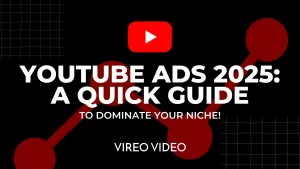Keeping track of your goals and results is an important part of succeeding with your marketing campaigns! The same remains true for YouTube content. If you’re looking to get ahead of your competitors, you should know the YouTube metrics that matter, and how to use that information to create winning content for your audience.
We understand YouTube analytics can be a bit overwhelming with so much to look at. So in this blog post, we break down the most important metrics to track!
Before we start, it’s important to remember that it takes time to see how successful videos are performing. Don’t jump to conclusions too early, give your videos time to be discovered! YouTube data is best used when looking at weeks or months at a time to uncover patterns amongst viewer habits. With that said, let’s get into it!
Need help understanding your YouTube metrics and growing your channel? Learn more about how we can help.
Jump to a section

1) Watch Time and Audience Retention
Watch Time is the total amount of time that viewers have spent watching your video. A high watch time is a great indicator that your content is capturing attention, and engaging for viewers. While video views used to be the primary signal for ranking on YouTube, Watch Time is now the most important metric to keep track of.
YouTube particularly likes this metric because the main goal of its algorithm is to keep viewers engaged with content on the website as long as possible. Here’s a few additional metrics to consider when looking at your watch time:
Average percentage viewed
A measurement of how much of a video your viewers watched on average.
This will help you understand how well your videos are holding the attention of your viewers. When a user clicks on the video, it means the topic interests them. However, if they aren’t watching for more than a few seconds, it can indicate an issue with your delivery.
Average view duration
This is the total watch time divided by the number of video plays.
If your content isn’t engaging, viewers are likely to click off of your video quickly, resulting in a lower average view duration. The lower this number is, the less likely YouTube is to push your content or position it above your competitors.
Audience retention
This shows when viewers are engaged with your content and when they leave.
Looking at this metric will show you exactly where your audience drops off, and which sections were played the most. This can help you identify what is working and what needs to change. Dive deeper into measuring key moments for audience retention from YouTube here.
Use your watch time data to make informed decisions on which content you should be producing to resonate and engage with your audience. Another helpful tactic is to keep track of trends in your data. Such as when users tend to drop off. We suggest going through your content and answering these questions:
- Is something specific appearing on screen?
- Is the pace of the video too slow?
- Is the video providing value?
- Are the title and thumbnail too clickbaity?
Over time, you’ll understand what changes you should make to provide your audience with the most pleasant and valuable viewing experience.

2) YouTube Impressions and CTR
Impressions measure how many times users were shown your video thumbnail and title on YouTube. This metric can be useful for understanding what content on your channel is getting picked up and recommend by YouTube.
Click-through rate (CTR) works in tandem with impressions by showcasing how many impressions became viewers. CTR is calculated by dividing the number of impressions by the number of users who clicked through to watch the content. A low CTR can indicate that your thumbnail or title isn’t convincing enough, or that it fails to show the topic or value of the video.
Is your content interesting enough?
Another reason for low CTR could be that the video topic itself is not interesting enough on its own. These metrics are extremely important on YouTube. This is because if users aren’t clicking on your content, YouTube will slow down its recommendations.
Keep an eye on this metric to understand what topics are garnering interest from your audience and for insight on what’s working for your thumbnails and titles. For more information on how to improve your CTR, check out our blog post.

3) YouTube Views and Unique Views
Views! This is usually one of the first YouTube metrics we all think of. However, let’s think about how we can get the most out of this metric by diving a bit deeper.
Let’s start with what the view metric measures: the number of times your video was watched for 30 seconds or more. Some things to remember about views:
- With views only counted after 30 seconds of watch time, it’s important that you start your video with a strong hook.
- Views can be a great indicator of popularity and video topic success. If a video is getting views, try making a few more on the same topic to see if it resonates with your audience.
- As one of the most public-facing metrics, views can be a factor in convincing users to watch. More views indicate many people found the video interesting or useful.
- A higher view count means many people found this interesting or useful, which can sway a user’s decision on whether to watch or not. Social proof is powerful!
- View count is the metric that is the most attractive to the general public.
To get even more out of views data, we can look at additional metrics like “unique viewers” and “average views per viewer.” This will tell you how many individual users chose to watch your video. It also showcases how often your video is being replayed by the same users.
More replays mean you are providing content that resonates with your audience. You should also keep an eye on your “returning viewers”. This metric can help ensure you are making content that your existing audience will enjoy while attracting new viewers as well.

4) YouTube Traffic Sources
Traffic Sources will tell you how users found your videos, and which sources are bringing the most views and watch time to your channel. There are three main sources to focus on within YouTube:
Browse features
- Traffic coming from the home page, subscriptions, watch history, watch later, trending, and personalized playlists.
- Tip: If you want to improve videos for your subscribers and existing audiences, look at what videos generate traffic from Browse Features.
Suggested traffic
- Traffic coming from suggestions appearing next to or after other videos on the platform, or links in video descriptions.
- Tip: Within YouTube analytics, you can see specific videos that have recommended your content. Take a look at those videos to gather insight on what’s working for them, and how you can incorporate a similar strategy into your own videos.
YouTube search
- Traffic coming from YouTube search results, including specific search terms used to find your content.
- Tip: Take a look at what search terms are generating traffic for your channel, and create more content around those topics and keywords. You can also use those search terms as a starting point for additional keyword research.
External and direct traffic is also valuable information, as it will allow you to see which other channels are contributing to your success. You can see web pages, and social media in this section, which can also be useful for measuring the success of your efforts on other platforms.
Ideally, you want to see Google Search near the top of this list, as that will indicate that your videos are properly optimized and in alignment with keywords and topics being searched across the web.
Additionally, playlist traffic sources can give you a good idea of what general subject matter is popular and being searched for. This can help you further define your content pillars for your ongoing strategy.

5) YouTube Demographics
If you’re using YouTube as a part of your content marketing strategy, there’s a good chance you already have an established buyer persona. If you’re not already familiar, a buyer persona is a profile of your ideal customer, including; who they are, what they do on a daily basis, and how they interact with the internet/content. Your demographic report within YouTube metrics will showcase your audience’s gender, age, and location.
The goal with this data is to understand who is actively watching your content, so you know who you’re speaking to. The idea is that this will align with your buyer persona, but if not, you should make adjustments to your content.
Alternatively, this information might provide you with more insight you can use to create a persona if you haven’t already. Understanding who you are making content for is crucial!
You're all set!
Now you’re ready to jump into these YouTube metrics with a better understanding to make the most out of your data. These are the top YouTube metrics that matter to consistently meet your goals and define your next move when it comes to strategy. We hope this has made the process a bit easier for you!
If this still seems like a lot, Vireo Video is here to help you! We regularly put out blogs to help simplify YouTube so that businesses can break down everything they need to know to be successful on the platform.
We’d love to chat with you if you’d like to dig in even deeper into your channel! Book a free consultation today.
Author: Mikayla Boudreau, Vireo Video blog contributor







